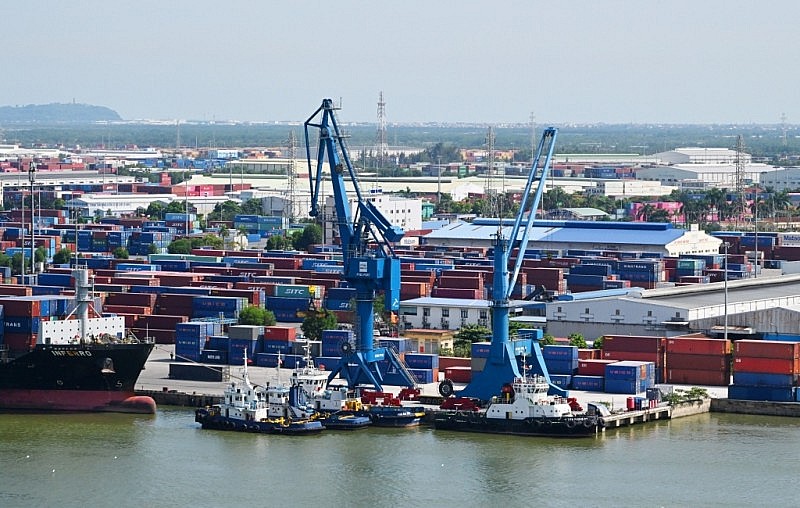The trade deficit returned after 23 consecutive months of trade surplus
A report from the General Statistics Office shows that merchandise export turnover in May 2024 is estimated to reach 32.81 billion USD, up 5.7% over the previous month and up 15.8% over the same period last year. Overall, in the first 5 months of 2024, merchandise export turnover is estimated to reach 156.77 billion USD, up 15.2% over the same period last year.
 |
| The trade deficit returned after 23 consecutive months of trade surplus |
In the opposite direction, the import turnover of goods in May 2024 is estimated to reach 33.81 billion USD, up 12.8% over the previous month and up 29.9% over the same period last year. In the first 5 months of 2024, import turnover is estimated at 148.76 billion USD, up 18.2% over the same period last year.
Thus, the trade balance of goods in May is estimated at a trade deficit of 1 billion USD. Overall, for the first 5 months of 2024, the trade balance of goods is estimated to have a trade surplus of 8.01 billion USD (the same period last year had a trade surplus of 10.2 billion USD).
Thus, after 23 consecutive months of trade surplus, trade deficit has returned. According to some experts, the trade deficit at this time is a good sign, proving that the economy is on the road to recovery. Businesses began to increase the import of machinery and raw materials for production to serve consumer and export needs. Specifically, data from the General Statistics Office has proven that in terms of the structure of imported goods in the first 5 months of 2024, the group of capital goods is estimated to reach 139.89 billion USD, accounting for 94%.
Entering the deficit, we should be more happy than worried
The newly released macro report of ACB Securities (ACBS) also commented that the trade deficit should be more happy than worried. “Vietnam recorded the first month of trade deficit in nearly 2 years with the trade deficit in May 2024 alone reaching 1 billion USD. At first glance, this seems to be bad news because it increases exchange rate pressure. However, when carefully analyzing each data, this can be a positive signal for the economy ," the report stated.
Also according to this report, imports increased sharply due to the need to import raw materials for production, especially electronics, electrical appliances and textiles. Therefore, current imports may be a step ahead of exports in these key areas. Slow import growth in 2023 also holds back the recovery of exports.
Looking back at the import-export trade picture in 2023, the report clearly states that although the trade surplus can help reduce pressure on exchange rates in 2023, in return the economy will also be gloomy in 2023. Therefore, , trade deficit at this time, although it creates exchange rate pressure in the short term, opens up a more positive signal for the recovery period in the production, processing, and manufacturing sectors in the near future.
In more detail, import figures increased clearly starting in early April, after a series of gloomy growth. Imported products focus on key materials for production, for example: Electronic components, computers, machinery and equipment, textile materials, iron and steel. In particular, imports of computer electronic components, machinery and equipment increased by 20 - 50% in May 2024 alone, which is expected to help Vietnam boost exports by 20 - 30% in the second half of 2024.
Strong growth of textile and garment materials (up 33% in May 2024 and more than 20% in the first 5 months of the year) signals that textile and garment orders will increase well in the second half of 2024. Import of iron and steel and products Iron and steel also increased sharply in April and May 2024 (up 16% and 47% respectively), of which more than 60% came from China. This can be considered a move to hoard cheap goods to serve growing consumer demand, while also coping with tax policy risks.
The trade deficit only returned in May, therefore, Dr. Le Duy Binh - Managing Director of Economica Vietnam - commented that this development cannot clearly determine the impact on the trade balance of goods for the whole year. Along with imports , the Purchasing Managers' Index (PMI), Industrial Production Index (IIP)... increased, showing that production is recovering. The growth rate of industrial production in some industries is higher, leading to the need to import goods and raw materials, while Vietnam's exports still depend heavily on imports.
According to data from the General Statistics Office, in terms of production, in May, the Industrial Production Index (IIP) was estimated to increase by 8.9% over the same period last year. Many industries serving exports increased compared to the same period last year, such as: Production of products from rubber and plastic increased by 24.1%; Wood processing and production of products from wood and bamboo increased by 23.0%; Electrical equipment production increased by 19.4%; Production of beds, wardrobes, tables and chairs increased by 18.8%; Production of electronic products, computers and optical products increased by 17.4%; Apparel production increased by 9.4%.
“The return of the trade deficit is a concern, but it can be expected that the sharp increase in the trade deficit due to the import of equipment, machinery, and raw materials for production is an indicator that industrial production will recover. more positive in the coming time ," said the General Statistics Office.
According to economic experts, in 2024, import demand will increase in the context of economic recovery, creating pressure on exchange rates , increasing the need to buy foreign currency. However, importing raw materials and inputs to serve the economic recovery process will create a premise to promote production and export activities, thereby creating foreign exchange revenue in the future. This cycle can relieve exchange rate pressure in the near future.



